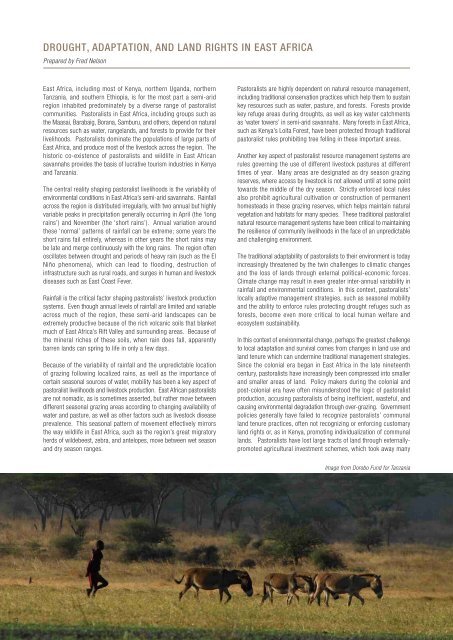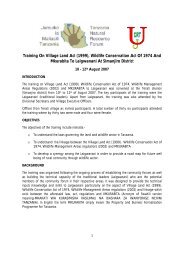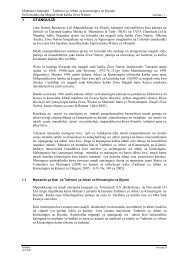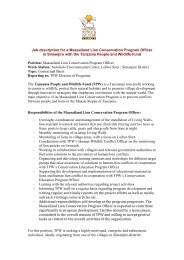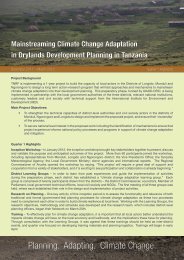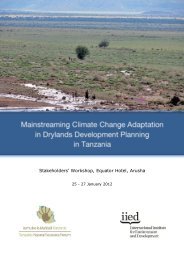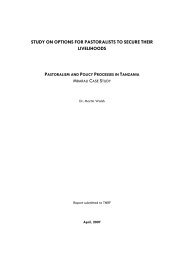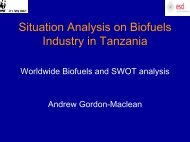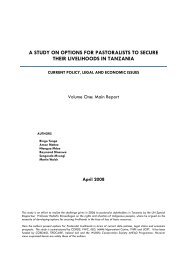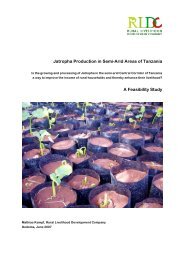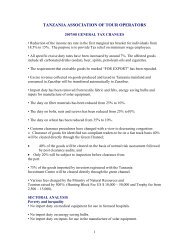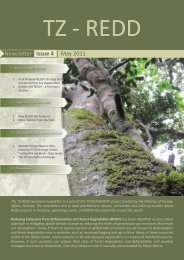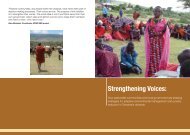DISPATCHES ON ADAPTATION
Dispatches_on_Adaptation - Tanzania Natural Resource Forum ...
Dispatches_on_Adaptation - Tanzania Natural Resource Forum ...
- No tags were found...
Create successful ePaper yourself
Turn your PDF publications into a flip-book with our unique Google optimized e-Paper software.
DROUGHT, ADAPTATI<strong>ON</strong>, AND LAND RIGHTS IN EAST AFRICA<br />
Prepared by Fred Nelson<br />
East Africa, including most of Kenya, northern Uganda, northern<br />
Tanzania, and southern Ethiopia, is for the most part a semi-arid<br />
region inhabited predominately by a diverse range of pastoralist<br />
communities. Pastoralists in East Africa, including groups such as<br />
the Maasai, Barabaig, Borana, Samburu, and others, depend on natural<br />
resources such as water, rangelands, and forests to provide for their<br />
livelihoods. Pastoralists dominate the populations of large parts of<br />
East Africa, and produce most of the livestock across the region. The<br />
historic co-existence of pastoralists and wildlife in East African<br />
savannahs provides the basis of lucrative tourism industries in Kenya<br />
and Tanzania.<br />
The central reality shaping pastoralist livelihoods is the variability of<br />
environmental conditions in East Africa’s semi-arid savannahs. Rainfall<br />
across the region is distributed irregularly, with two annual but highly<br />
variable peaks in precipitation generally occurring in April (the ‘long<br />
rains’) and November (the ‘short rains’). Annual variation around<br />
these ‘normal’ patterns of rainfall can be extreme; some years the<br />
short rains fail entirely, whereas in other years the short rains may<br />
be late and merge continuously with the long rains. The region often<br />
oscillates between drought and periods of heavy rain (such as the El<br />
Niño phenomena), which can lead to flooding, destruction of<br />
infrastructure such as rural roads, and surges in human and livestock<br />
diseases such as East Coast Fever.<br />
Rainfall is the critical factor shaping pastoralists’ livestock production<br />
systems. Even though annual levels of rainfall are limited and variable<br />
across much of the region, these semi-arid landscapes can be<br />
extremely productive because of the rich volcanic soils that blanket<br />
much of East Africa’s Rift Valley and surrounding areas. Because of<br />
the mineral riches of these soils, when rain does fall, apparently<br />
barren lands can spring to life in only a few days.<br />
Because of the variability of rainfall and the unpredictable location<br />
of grazing following localized rains, as well as the importance of<br />
certain seasonal sources of water, mobility has been a key aspect of<br />
pastoralist livelihoods and livestock production. East African pastoralists<br />
are not nomadic, as is sometimes asserted, but rather move between<br />
different seasonal grazing areas according to changing availability of<br />
water and pasture, as well as other factors such as livestock disease<br />
prevalence. This seasonal pattern of movement effectively mirrors<br />
the way wildlife in East Africa, such as the region’s great migratory<br />
herds of wildebeest, zebra, and antelopes, move between wet season<br />
and dry season ranges.<br />
Pastoralists are highly dependent on natural resource management,<br />
including traditional conservation practices which help them to sustain<br />
key resources such as water, pasture, and forests. Forests provide<br />
key refuge areas during droughts, as well as key water catchments<br />
as ‘water towers’ in semi-arid savannahs. Many forests in East Africa,<br />
such as Kenya’s Loita Forest, have been protected through traditional<br />
pastoralist rules prohibiting tree felling in these important areas.<br />
Another key aspect of pastoralist resource management systems are<br />
rules governing the use of different livestock pastures at different<br />
times of year. Many areas are designated as dry season grazing<br />
reserves, where access by livestock is not allowed until at some point<br />
towards the middle of the dry season. Strictly enforced local rules<br />
also prohibit agricultural cultivation or construction of permanent<br />
homesteads in these grazing reserves, which helps maintain natural<br />
vegetation and habitats for many species. These traditional pastoralist<br />
natural resource management systems have been critical to maintaining<br />
the resilience of community livelihoods in the face of an unpredictable<br />
and challenging environment.<br />
The traditional adaptability of pastoralists to their environment is today<br />
increasingly threatened by the twin challenges to climatic changes<br />
and the loss of lands through external political-economic forces.<br />
Climate change may result in even greater inter-annual variability in<br />
rainfall and environmental conditions. In this context, pastoralists’<br />
locally adaptive management strategies, such as seasonal mobility<br />
and the ability to enforce rules protecting drought refuges such as<br />
forests, become even more critical to local human welfare and<br />
ecosystem sustainability.<br />
In this context of environmental change, perhaps the greatest challenge<br />
to local adaptation and survival comes from changes in land use and<br />
land tenure which can undermine traditional management strategies.<br />
Since the colonial era began in East Africa in the late nineteenth<br />
century, pastoralists have increasingly been compressed into smaller<br />
and smaller areas of land. Policy makers during the colonial and<br />
post-colonial era have often misunderstood the logic of pastoralist<br />
production, accusing pastoralists of being inefficient, wasteful, and<br />
causing environmental degradation through over-grazing. Government<br />
policies generally have failed to recognize pastoralists’ communal<br />
land tenure practices, often not recognizing or enforcing customary<br />
land rights or, as in Kenya, promoting individualization of communal<br />
lands. Pastoralists have lost large tracts of land through externallypromoted<br />
agricultural investment schemes, which took away many<br />
Image from Dorobo Fund for Tanzania<br />
3


